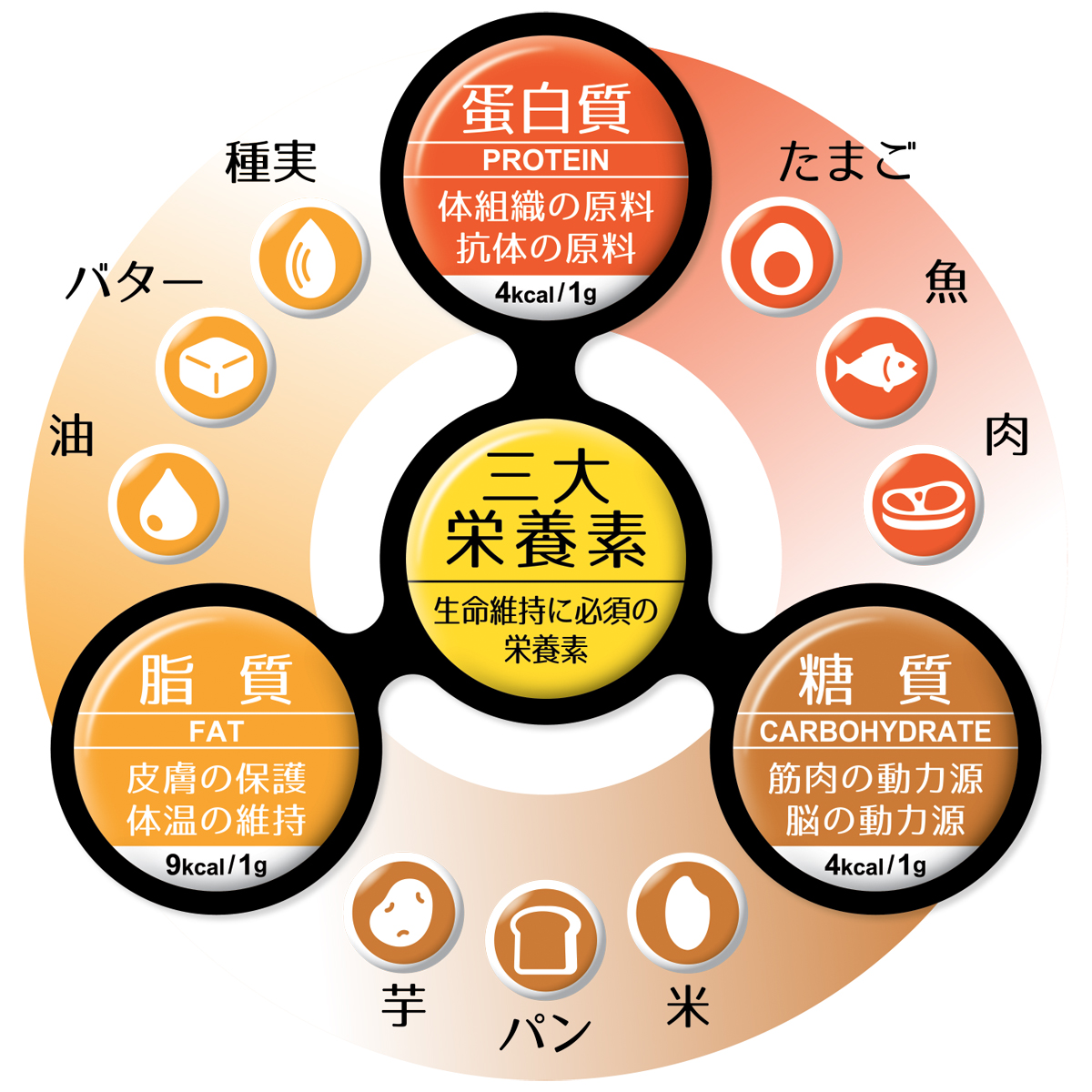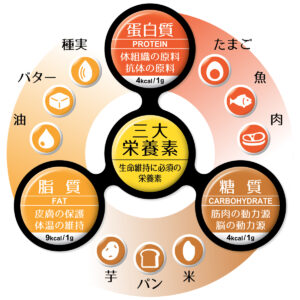ダイエット【その2】で「1日の消費カロリー」が計算できましたので、ダイエット【その3】では摂取カロリーの計算方法を説明します。
摂取カロリーの計算には、タンパク質(Protein)、脂質(Fat)、炭水化物(Carbohydrate)の三大栄養素を基にして、摂取量(食事)を調整します。(三大栄養素の頭文字をとって「PFCバランス」といいます。)
抑えておきたい基本の数字(PFCのもつエネルギー)
摂取カロリー(食べる量)を計算するには、それぞれの重さに対するエネルギー量を知っておく必要があります。
F:脂質(Fat)=9kcal/g
C:炭水化物(Carbohydrate)=4kcal/g
摂取カロリーの計算手順
- 1日の消費カロリーを知る:ダイエット【その2】での計算結果。
- 目標の設定:ダイエットの期間と、1ヶ月で落とす脂肪量を決める。
- 1日に摂取可能なカロリーを設定する:基礎代謝を下回らないこと注意して、落とす脂肪量のカロリーを割り出す。
- PFCバランスを調整する:PFCのもっているエネルギーを基に摂取カロリーと栄養バランスを調整する。
- モニタリングとPFCバランスの再調整:定期的に経過を観察して、PFCバランスを再調整する。
ダイエット目標の設定
目標の設定は、体脂肪率を目安にするのがいいでしょう。
【目標設定の例】
体重70kg・体脂肪率25%の人が5か月間で10kgの脂肪を落とすことを目標に計算。
現状と目標の把握
| 現 状 | 目 標 | |
| 体 重 | 70kg | 60kg |
| 体脂肪率 | 25.0% | 12.5% |
| 体脂肪量 | 17.5kg(70kg×0.25) | 7.5kg(60kg×0.125) |
※ 脂肪を1kg燃焼させるには、7,200kcal程度のエネルギーが必要になります。
5か月間で10kgの脂肪を落とすとすれば、1ヶ月に2kgが目標。
1ヶ月に2kg(14,400kcal)を1日のカロリーに換算すると480kcal(14,400÷30日)。
つまり、1日に摂取するカロリーを少なくするか、消費するカロリーを多くする具体的な数字が1日に480kcalということです。
にすると、1ヶ月に2kg痩せます。
※ 1日の消費カロリー=基礎代謝(BMR)×生活強度指数(ダイエット【その2】の計算)
食べて痩せるの本当の意味
アスリートたちは「食べて痩せろ」とよくいいますが、これは食べた分だけトレーニングでカロリーを消費しろという意味です。
トレーニングをすると筋肉が発達して基礎代謝も上がり体脂肪も燃焼しやすくなります。
ダイエットで絶対にやってはいけない事は、基礎代謝より摂取カローリーを低くすることです。
体重を落とすだけの間違ったダイエットは、みすぼらしい体型になったり、内臓や脳にも悪影響が出るので注意しましょう。
ダイエット【その2】で紹介の(基礎代謝=370+21.6×除脂肪体重)を下回る目標設定はNG!
PFCバランス
「PFCバランス」とは、摂取カロリーに対する三大栄養素の構成比率のことをいいます。
「P(タンパク質)=4(kcal)」
「F(脂質)=2(kcal)」
「C(炭水化物)=4(kcal)」
この構成比率を重さ(グラム)に換算したものが具体的な食品の摂取量です。
PFCバランス「4:2:4」の具体例
摂取カロリーの目標を2,000kcalと仮定して、PFCバランス「4:2:4」の計算。
F=2,000×2/10=400kcal(400kcal÷9kcal/g≒45g)
C=2,000×4/10=800kal(800kcal÷4kcal/g=200g)
1日の摂取量:P(タンパク質)=200g、F(脂質)=45g、C(炭水化物)=200g
この様に具体的に1日に食べる量を算出します。
最初に値を決定するのは大切なF(脂質)
PFCのうち最初に決定するF(脂質)の比率は10%~20%です。
ダイエット食に脂質は天敵と思われるかもしれませんが、脂質は細胞膜やホルモンの原料には欠かせない栄養素です。
特にα―リノレン酸、リノール酸などは、必須脂肪酸(体内で合成できない脂肪酸)の摂取は欠かせません。
脂質にはダイエット時に満腹感与えたり、脂溶性ビタミンの吸収に役立ちます。またココナッツオイルなどに含まれている中鎖脂肪酸(MCTオイル)などは一般的な油に比べて、4~5倍も速く分解され、短時間でエネルギーになります。
摂取カロリーを2,000kcalとした場合の計算例
摂取カロリーの10%~20%で計算すると
(200~400kcal)÷9kcal/g≒22g~45g
おおよその摂取量が22g~45gになります。
除脂肪体重の1.5倍から2.0倍摂りたいP(タンパク質)
次に決定するのはP(タンパク質)です。
筋肉を大きくしたいボディービルダーなどは除脂肪体重の4.0/1,000g以上も摂る人もいますが、過剰摂取は骨粗鬆症や腎臓に負荷がかかるリスクがあるので、一般の人は除脂肪体重の1.5/1,000g~3.0/1,000g程度を目安にすればいいと思います。
タンパク質はアミノ酸の集合体で、必須アミノ酸(体内で合成できないアミノ酸)がふくまれているので欠かす事は出来ません。
摂取量の計算は、ダイエット【その2】で算出した除脂肪体重に1.5/1,000g~3.0/1,000gを掛ければ算出できます。
摂取タイミングが重要なC(炭水化物)
PFCの構成比率で最後に決定するのはC(炭水化物)です。
計算方法は「1日の摂取カロリー」から先ほど計算した「脂質のカロリー」と「タンパク質のカロリー」を差し引いた残りのカロリーです。
脂質とタンパク質には食事でしか摂れない「必須」といわれるものがあります。これに対して炭水化物には必須といわれるものはありませんが、体にとって重要な栄養素です。
人間の体は長期間、同じ食事を続けていると「省エネモード」に入り消費カロリーを抑える機能が備わっているので、PとCのバランスは時折変化させて刺激を与えるのがいいでしょう。
具体的な計算例
簡単に計算の通りになりませんが、体脂肪率10%前後までは一般の人でも無理なくできる範囲です。
男性で10%~15%、女性なら18%~21%程度なら根気よく取り組めば実現します。
1. 目標の設定
体重60kg、体脂肪率25%の人が6ヶ月間で脂肪を12kg落とすと仮定します。
目標値は、体重48kg、体脂肪率6.25%です。
2. 目標摂取カロリーの算出
1. 除脂肪体重を算出する。
体重×((100-体脂肪率)/100)=60×((100-25)/100)=45kg
2. 基礎代謝を算出する。
370+21.6×除脂肪体重=370+21.6×45=1,342kcal
3. 消費カロリーを算出する(生活強度を適度と仮定)
基礎代謝×生活強度指数=1,342×1.7=2,281kcal
4. 落とす脂肪カロリーを算出する。(6ヶ月で12kg減は、1ヶ月2kg減)
脂肪1kg落とすには、7,200kcal程のエネルギーが必要なので
1ヶ月に2kgは14,400kcal=1日に480kcal(14,400÷30日)
5. 目標の摂取カロリーを算出する
消費kcal-落とす脂肪kcal=2,281-480≒1,800kcal
3. PFCバランスの調整
1. P(タンパク質)の摂取量(除脂肪体重の2倍と仮定)
「除脂肪体重」×2=45×2=90g(4×90=360kcal)
2. F(脂質)の摂取量(摂取カロリーの20%と仮定)
「目標摂取カロリー」×0.2=1,800×0.2=360kcal(360÷9=40g)
3. C(炭水化物)の摂取量
「目標摂取カロリー」-「Pの摂取量」-「Fの摂取量」
=1,800-360-360=1,080kcal(1,080÷4=270g)
【計算結果】
体重60kg、体脂肪率25%の人が毎月2kgの脂肪を落とすには
1日にP=90g、F=40g、C=270gになりました。
これは一例ですのでご自身で調整してください。
食品の成分を知りたいときは文部科学省の「食品データベース」が検索しやすいと思います。
毎日食事のカロリーを計算するのは大変です。最初は手間が掛かりますが、何回か計算すると感覚でわかるようになるので取り入れてみて下さい。
今回は、三大栄養素で摂取カロリーの調整方法でした。
ダイエットシリーズ【その1】から【その5】
ダイエットに必要な具体的な計算方法を記事にしていますので順番に読んでみてください!
〇 ダイエット【その2】1日の消費カロリーを知る
〇 ダイエット【その3】三大栄養素で摂取カロリーを調整する
〇 ダイエット【その4】食事の摂り方
〇 ダイエット【その5】腸内環境を整える


